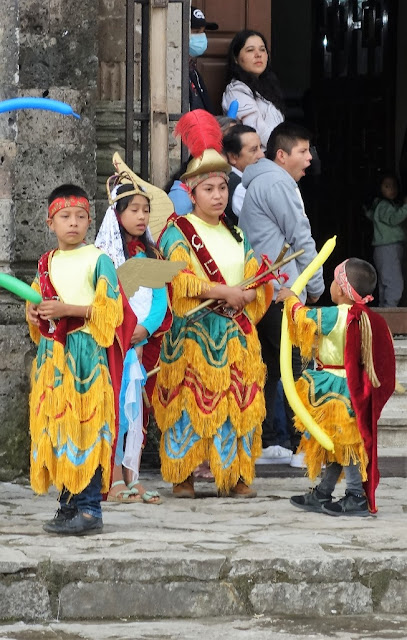After we finally arrived in Cuetzalan and got settled into our hotel, we set out to explore this town which has been designated a "Pueblo Mágico" (Magic Town) by the Mexican tourism department. I have visited a number of "Pueblos Mágicos", but Cuetzalan is definitely one of the most magical towns that I have seen. The afternoon was cloudy, but the heavy rain which had occurred shortly before our arrival had passed.
We set out for the town square which is dominated by the Church of San Francisco de Asís which was established by the Franciscan friars who founded the town in 1547.
The interior of the church
The church was decked out with floral arrangements. A little later they were going to have a mass celebrating a girl's "quinceañera" (15th birthday).
It would seem that a specialty of the area is the creation of elaborate wax candles. There were several of them in the church.
In the square in front of the church there is a wooden pole, apparently made from the trunk of one very tall tree. This is where the "voladores" (flyers) perform their pre-Hispanic ceremony. I have seen the "voladores" in several places, but this is the region of Mexico where the ceremony originated. Five "voladores" climb to the top of the pole. One of them sits on a small platform at the top and plays a flute and beats a drum. The other four tie their feet to ropes. They hurl themselves from the top, and spin around the pole. The ropes unfurl until they reach the ground.
Next to the church, is a flight of steps (there isn't much level ground in this hilly town) leads up to a plaza with a bandstand and a clock tower that was erected in 1910 for the centennial of Mexico's independence.
The town hall
Alejandro and I wandered the cobblestone streets, most of them going uphill and down. The buildings are generally whitewashed and have red tile roofs. The roofs project out to provide shelter from the region's rainy climate.
(Notice the flock of pigeons about to fly from their roost on the edge of the roof.)
Cuetzalan may be a small town, but for the inhabitants of the surrounding villages in the countryside, it is the urban center. Many of the indigenous people who come into town wear their traditional attire. Their mother tongue is Nahuatl, the language of the Aztecs.
While we were wandering we heard a band playing and saw a procession a block away. We followed the procession as it made its way back to the church.
The procession stopped in the plaza in front of the church, waiting, I assume for the "quinceañera" mass to finish.
A number of the participants were dressed in the costume of the "quetzal" dancers.
Some of the children were dressed in winged costumes.
Other children were dressed in white robes.
Since so many of the participants were children, I thought that the procession might have something to do with "Children's Day" which was the following day. Alejandro, however, said no.
Anyway, we left them to continue our exploration. We walked to the opposite side of town to see the other principal church in Cuetzalan, the Sanctuary of the Virgin of Guadalupe. The church was built in the late 1800s in a French Gothic style.
In front of the church is the city cemetery. Many of the graves were decorated with flowers.
Our first day in Cuetzalan had come to an end, but there was more to see in the next two days.





























Thank you for the virtual visit to such an interesting snd pretty town. I just twirled the Volares toy I bought in CDMX when I visited with you there.
ReplyDeleteIt is one of the most unique places that I have visited in my many trips to Mexico.
Delete